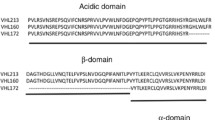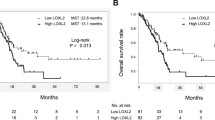Abstract
Lysyl oxidase-like enzymes (LOXL) are expressed in various cancers. We analyzed the expression of LOXL2, LOXL3, and LOXL4 in cancers involving the serosal cavities—breast carcinoma, ovarian carcinoma, and malignant mesothelioma using reverse-transcriptase polymerase chain reaction. We discovered two new alternative splice variants of LOXL4. The spliced segments were exon 9 (splice variant 1) or both exons 8 and 9 (splice variant 2). In ovarian carcinoma, splice variant 1 was significantly elevated in effusions compared to solid lesions (p < 0.001). Splice variant 2 appeared only in effusions. In breast carcinoma, LOXL4 was expressed only in the effusion samples. In malignant mesothelioma, LOXL4 and its splice variants were expressed at all sites. Breast carcinoma effusions showed significantly higher LOXL2 (p = 0.003) and lower LOXL3 (p < 0.001) expression compared to primary carcinomas. Our data show differences in LOXL messenger RNA expression as a function of anatomic site and tumor type in cancers affecting the serosal cavities.




Similar content being viewed by others
References
Kagan HM, Li W (2003) Lysyl oxidase: properties, specificity, and biological roles inside and outside of the cell. J Cell Biochem 88:660–672
Holtmeier C, Görögh T, Beier U et al (2003) Overexpression of a novel lysyl oxidase-like gene in human head and neck squamous cell carcinomas. Anticancer Res 23:2585–2591
Giampuzzi M, Botti G, Cilli M et al (2001) Down-regulation of lysyl oxidase-induced tumorigenic transformation in NRK-49F cells characterized by constitutive activation of ras proto-oncogene. J Biol Chem 276:29226–29232
Contente S, Kenyon K, Sriraman P et al (1999) Epigenetic inhibition of lysyl oxidase transcription after transformation by ras oncogene. Mol Cell Biochem 194:79–91
Lazarus HM, Cruikshank WW, Narasimhan N et al (1995) Induction of human monocyte motility by lysyl oxidase. Matrix Biol 14:727–731
Li W, Nellaiappan K, Strassmaier T et al (1997) Localization and activity of lysyl oxidase within nuclei of fibrogenic cells. Proc Natl Acad Sci U S A 94:12817–12822
Molnar J, Fong KS, He QP et al (2003) Structural and functional diversity of lysyl oxidase and the LOX-like proteins. Biochim Biophys Acta 1647:220–224
Maki JM, Kivirikko KI (2001) Cloning and characterization of a fourth human lysyl oxidase isoenzyme. Biochem J 355:381–387
Liu X, Zhao Y, Gao J et al (2004) Elastic fiber homeostasis requires lysyl oxidase-like 1 protein. Nat Genet 36:178–182
Kirschmann DA, Seftor EA, Fong SF et al (2002) A molecular role for lysyl oxidase in breast cancer invasion. Cancer Res 62:4478–4483
Akiri G, Sabo E, Dafni H et al (2003) Lysyl oxidase-related protein-1 promotes tumor fibrosis and tumor progression in vivo. Cancer Res 63:1657–1666
Fong SF, Dietzsch E, Fong KS et al (2007) Lysyl oxidase-like 2 expression is increased in colon and esophageal tumors and associated with less differentiated colon tumors. Genes Chromosomes Cancer 46:644–655
Peinado H, Del Carmen Iglesias-de la Cruz M, Olmeda D et al (2005) A molecular role for lysyl oxidase-like 2 enzyme in snail regulation and tumor progression. Embo J 24:3446–3458
Wu G, Guo Z, Chang X et al (2007) LOXL1 and LOXL4 are epigenetically silenced and can inhibit Ras/extracellular signal-regulated kinase signaling pathway in human bladder cancer. Cancer Res 67:4123–4129
Jemal A, Siegel R, Ward E et al (2008) Cancer statistics, 2008. CA Cancer J Clin 58:71–96
Goff BA, Mandel L, Muntz HG et al (2000) Ovarian carcinoma diagnosis. Cancer 89:2068–2075
Davidson B, Risberg B, Reich R et al (2003) Effusion cytology in ovarian cancer: new molecular methods as aids to diagnosis and prognosis. Clin Lab Med 23:729–754
Britton M (2002) The epidemiology of mesothelioma. Semin Oncol 29:18–25
Van Ruth S, Baas P, Zoetmulder FAN (2003) Surgical treatment of malignant pleural mesothelioma. Chest 123:551–561
Sugarbaker PH, Welch LS, Mohamed F et al (2003) A review of peritoneal mesothelioma at the Washington Cancer Institute. Surg Oncol Clin N Am 12:605–621
Feldman AL, Libutti SK, Pingpank JF et al (2003) Analysis of factors associated with outcome in patients with malignant peritoneal mesothelioma undergoing surgical debulking and intraperitoneal chemotherapy. J Clin Oncol 21:4560–4567
Hausheer FH, Yarbro JW (1985) Diagnosis and treatment of malignant pleural effusion. Semin Oncol 12:54–75
Martinez-Moragon E, Aparicio J, Sanchis J et al (1998) Malignant pleural effusion: prognostic factors for survival and response to chemical pleurodesis in a series of 120 cases. Respiration 65:108–113
Wilkes JD, Fidias P, Vaickus L et al (1995) Malignancy-related pericardial effusion. 127 cases from the Roswell Park Center Institute. Cancer 76:1377–1387
Dieterich M, Goodman SN, Rojas-Corona RR et al (1994) Multivariate analysis of prognostic features in malignant pleural effusions from breast cancer patients. Acta Cytol 38:945–952
Banerjee AK, Willetts I, Robertson JF et al (1994) Pleural effusion in breast cancer: a review of the Nottingham experience. Eur J Surg Oncol 20:33–36
Davidson B, Nielsen S, Christensen J et al (2001) The role of Desmin and N-cadherin in effusion cytology. A comparative study using established markers of mesothelial and epithelial cells. Am J Surg Pathol 25:1405–1412
Borel A, Eichenberger D, Farjanel J et al (2001) Lysyl oxidase-like protein from bovine aorta: Isolation and maturation to an active form by bone morphogenetic protein-1. J Biol Chem 276:48944–48949
Csiszar K (2001) Lysyl oxidases: A novel multifunctional amine oxidase family. Prog Nucleic Acid Res Mol Biol 70:1–32
Hayashi K, Fong KS, Mercier F et al (2004) Comparative immunocytochemical localization of lysyl oxidase (LOX) and the lysyl oxidase-like (LOXL) proteins: Changes in the expression of LOXL during development and growth of mouse tissues. J Mol Histol 35:845–855
Butler E, Hardin J, Benson S (1987) The role of lysyl oxidase and collagen crosslinking during sea urchin development. Exp Cell Res 173:174–182
Payne SL, Fogelgren B, Hess AR et al (2005) Lysyl oxidase regulates breast cancer cell migration and adhesion through a hydrogen peroxide-mediated mechanism. Cancer Res 65:11429–11436
Hohenester E, Sasaki T, Timpl R (1999) Crystal structure of a scavenger receptor cysteine-rich domain sheds light on an ancient superfamily. Nat Struct Biol 6:228–232
Sasaki T, Brakebusch C, Engel J et al (1998) Mac-2 binding protein is a cell-adhesive protein of the extracellular matrix which self-assembles into ring-like structures and binds beta1 integrins, collagens and fibronectin. EMBO J 17:1606–1613
Acknowledgments
This work was supported by the Norwegian and Israeli Cancer Societies and by the Research Foundation at the Radiumhospitalet. We wish to thank Mr. Søren Nielsen for the kind permission to use the malignant mesothelioma effusions from Aalborg Hospital in this study.
Conflict of interest statement
We declare that we have no conflict of interest.
Author information
Authors and Affiliations
Corresponding author
Rights and permissions
About this article
Cite this article
Sebban, S., Davidson, B. & Reich, R. Lysyl oxidase-like 4 is alternatively spliced in an anatomic site-specific manner in tumors involving the serosal cavities. Virchows Arch 454, 71–79 (2009). https://doi.org/10.1007/s00428-008-0694-6
Received:
Revised:
Accepted:
Published:
Issue Date:
DOI: https://doi.org/10.1007/s00428-008-0694-6




